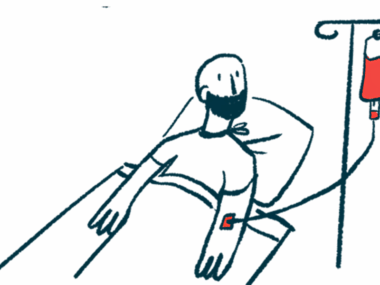Structure at Varying Stages of AChR Receptor, Damaged by MG, Detailed
Written by |

Researchers report having uncovered the atomic structure of the acetylcholine receptor, the target of the abnormal immune response that causes most cases of myasthenia gravis (MG).
They also detailed how the receptor is activated by changes in its shape when combined with two small molecules. Their work could help to guide the development of treatments that enhance receptor activity and improve muscle function in MG and similar disorders, such as congenital myasthenic syndrome.
“These structures will help us understand the molecular processes that underlie both diseases and may eventually help us design therapeutics,” John Baenziger, PhD, a professor in the Department of Biochemistry, Microbiology, and Immunology at the University of Ottawa, in Canada, and the study’s co-senior author, said in a university press release.
The study, “Conformational transitions and ligand-binding to a muscle-type nicotinic acetylcholine receptor,” was published in the journal Neuron.
In most cases of MG, antibodies generated by an abnormal immune response target and damage the acetylcholine receptor (AChR), a protein located on the surface of muscle cells within the neuromuscular junction — the place where nerve cells communicate with the muscles they control.
Normally, when triggered by an electrical signal, nerve cells within the junction release a signaling molecule called acetylcholine — a neurotransmitter — that binds to and changes the shape of the AChR protein. This shape change causes AChR to open, like a gait, allowing the flow of such positively charged ions as sodium and potassium in and out of muscle cells, triggering a contraction.
Damage to AChR by MG-related antibodies disrupts communication between nerves and muscles, resulting in muscle fatigue and weakness.
Understanding the structural details of the AChR protein at the atomic level, and how it changes shape when it binds to activators can guide work into medicines that also bind to and activate the damaged AChRs of MG patients, potentially improving their muscle strength.
“To better understand how these proteins work and to better understand how to target them with pharmaceuticals we need to solve their structures and then understand how neurotransmitter binding changes their structures leading to their activation,” Baenziger said.
In collaboration with Hugues Nury, PhD, at the Université Grenoble Alpes, in France, the team used a technique called cryo-electron microscopy to determine AChR’s structure. The protein was isolated from a species of electric rays known as the torpedo ray, which has an abundance of AChRs similar to those found in humans.
The team also determined the structures of the AChR protein with different molecules that bind and activate the receptor (agonists), such as nicotine, the addictive compound found in tobacco, and the approved eye medicine carbachol (carbamylcholine), which has a structure almost identical to acetylcholine.
Observing the changes in AChR when exposed to different activating molecules shows how the receptor functions, but also sheds light on potential therapeutic target sites.
“The structural changes underlying channel activation remain undefined,” the team wrote.
AChR is composed of five chains of amino acids, the building blocks of proteins. Structural analysis showed these five chains together form a tube-like structure, with about half of the receptor sitting outside the cell and the remaining half embedded within the cell membrane.
When combined with nicotine and carbachol, the AChR changed shape; researchers then examined the atomic details of how the two molecules bound to the protein and caused its atoms to move.
These findings were correlated with biochemical tests that measured AChR function under conditions that would typically occur within the neuromuscular junction. Computer simulations called dynamics were also run to monitor atom movement between the different AChR shapes and estimate the flow of ions through the gait when activated.
Biochemical tests showed that nicotine and carbachol bound AChR at different strengths (affinities). Structural analysis demonstrated that these two molecules targeted different sites on the AChR protein, which established the “structural basis for the differential agonist affinities,” the researchers wrote.
Results also highlighted previously under-appreciated functions of the different protein chains that form the AChR, which played a complementary role in opening the receptor gait.
Researchers also showed the structural reasons why nicotine binds to AChRs found in muscles more weakly, and thus less potently, than to AChR found in nerve cells.
Baenziger plans to return to France and continue working with Nury.
“I hope that many more exciting things will come out of this collaboration,” he said.







Leave a comment
Fill in the required fields to post. Your email address will not be published.